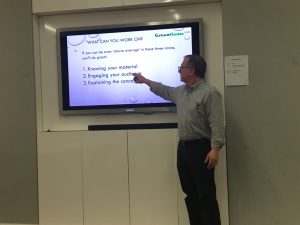Green Careers: Presentation Skills Workshop Recap
June 27, 2019
By Melanie Mason On Tuesday, June 11th, GreenHome NYC was excited to host one of our board members, Paul Reale, to lead a workshop on presentation skills. Paul is also the Director of Building Operations Research and Training at CUNY Building Performance Lab. He shared his experience presenting in various settings, including conferences and classrooms, and brought enthusiasm and expertise to a group of young professionals looking to further their skills. For those who missed this interactive workshop, you can check out Paul’s 13 pieces of advice here:
On Tuesday, June 11th, GreenHome NYC was excited to host one of our board members, Paul Reale, to lead a workshop on presentation skills. Paul is also the Director of Building Operations Research and Training at CUNY Building Performance Lab. He shared his experience presenting in various settings, including conferences and classrooms, and brought enthusiasm and expertise to a group of young professionals looking to further their skills. For those who missed this interactive workshop, you can check out Paul’s 13 pieces of advice here:
1) Be yourself Don’t change yourself or pretend when you’re standing in front of an audience. The audience will be able to see through the phony and, besides, they came to see YOU present.
2) Know your material Take the time to study your material so that you can speak confidently to every point. This way, when you’re in front of an audience, you don’t have to think about what to say, just how to communicate it.
3) Know your audience Knowing your audience helps you determine how much background you need to give. If you can’t get enough information about them beforehand, you can ask questions in the beginning to find out who they are. For example, say “Raise your hand if you work in sustainability.”
4) Face forward This one goes hand in hand with knowing your material, so you can minimize the time you look away from the audience. If you’re using slides, position yourself so you can glance at them from the side and put your laptop in front of you so you can control the slide transitions.
5) Set up the room If you have control over the space, arrive early so you can set up the room. Get rid of extra seats. Otherwise the front row may remain empty, creating a barrier between you and the audience. Make sure your equipment is working and ready to go. Try not to stand behind a podium because it’s another barrier between you and your audience.
6) Manage your time Be conscious of how much time you have left and try not to get behind in your presentation. You may want to save questions until the end. If you’re running out of time, remember to get your main point across even if you can’t get through all of your slides.
7) Warm up the audience In a classroom or meeting setting, start with quick introductions and take note to remember people’s names. One trick is to repeat the name back to each person you meet.
8) Silence, fear and knowing everything Silence is okay. Pause to let the audience digest what you’ve said. It’s okay to be nervous about speaking in front of people – pretty much everyone is! Don’t pretend to know everything. It’s okay to say “I don’t know.” You can even ask the audience if they know the answer to a question.
9) Get the audience to talk Ask questions to engage with the audience. If you have a quiet audience, ask closed ended questions so it’s not too awkward if no one responds. Asking more questions throughout your presentation keeps the audience engaged, but remember to keep track of your time.
10) Use other engagement techniques besides asking questions Make frequent eye contact, speak clearly, and minimize reading directly from slides.
11) Use short anecdotes Anecdotes and personal stories can be useful in conveying concepts or building rapport with your audience.
12) Address distractions If someone is continuously having a side conversation during your presentation, don’t embarrass them but instead say, “Something worth adding?” Odds are that person is talking about your topic.
13) Manage types If you have the “talkative one,” put their comment on hold until you finish your point or say “Let’s give someone else a chance.” If you have the “shy one,” call on them occasionally and don’t put them on the spot too much. If you have the “adversary one,” who either doesn’t believe you or wants to compete, validate their point and acknowledge that there are always new perspectives .
This simple tool kit should take you a long way to a great talk. Good luck with your next presentation!

Thank you to Grohe for hosting us and doing your part to promote sustainable practices through your household water conservation technology.
